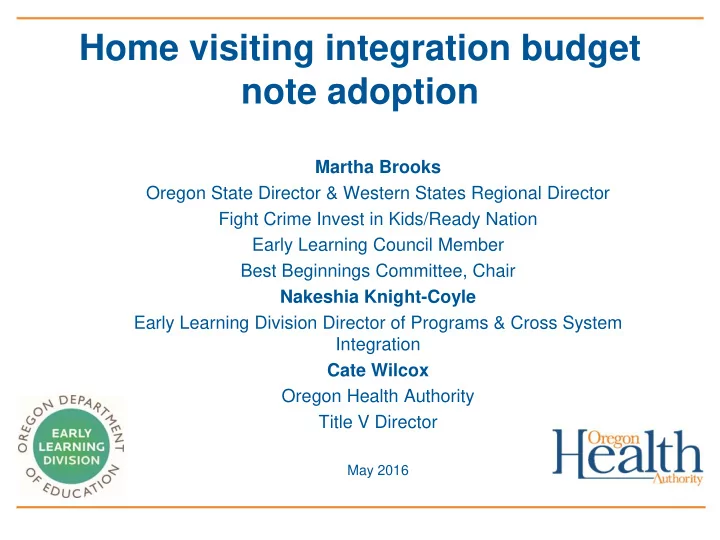

Home visiting integration budget note adoption Martha Brooks Oregon State Director & Western States Regional Director Fight Crime Invest in Kids/Ready Nation Early Learning Council Member Best Beginnings Committee, Chair Nakeshia Knight-Coyle Early Learning Division Director of Programs & Cross System Integration Cate Wilcox Oregon Health Authority Title V Director May 2016
Budget Note Review 1. Establish common outcomes and outcome measures for state funded home visiting programs. 2. Identify characteristics all programs look for regardless of model and establish common data elements to use when screening families for programs. 3. Develop a professional development, education and support system for professionals in the home visiting workforce. 2
Budget Note Intent • To ensure home visiting and early learning program success in reaching children and families in need of services through integrated early learning, health transformation and home visiting systems. ELC’s Best Beginnings Committee lead development of recommendations, jointly staffed by OHA and ELD staff as well as national technical assistance from the National Center for Infants, Toddlers and Families (Zero To Three). 3
Our Approach • Define home visiting: Programs that strengthen family bonds and understanding of human development to support healthy growth and development and family self-sufficiency. • Define age range: – Primary population: prenatal to 5 years old – Secondary population: 6-8 years old • Build on what already exists when possible. • Keep the work moving and allow it to iterate, grow and continue to develop. The work of implementing system improvement is never done. 4
Outcome Metrics Categories • Improve equity across all communities • Improve maternal, infant and family health and well being. • Prevent childhood accidental injury, abuse, and neglect, and reduction in crime and family violence. • Improve school readiness and achievement. • Improve family self-sufficiency and coordination of community resources. (See handout for proposed outcomes and measures.) 5
Entry Questionnaire • Set the standard based on collecting required data points • Considered five forms that currently exist – The Home Visiting Entry Questionnaire (HVEQ) – The New Baby Questionnaire (NBQ) used by Healthy Families Oregon, – The Family Coordinated 0-5 years Referral Exchange (Family C0RE) used in Yamhill County, – The Early Learning Family Support Referral Form (ELFSRF) used in Marion County, and – The Early Intervention Early Childhood Special Education (EI/ECSE) Universal Referral Form. • Prioritize elements that were common in at least three of the five forms or are considered best practice. • Elements that are predictive of maltreatment and foster care entry before age six should also be considered to inform the development of the questionnaire. 6
Entry Questionnaire Volunteer Home Visiting Parent Coaching Programs Most Common Data Points: • Parents name and baby’s name * Parent age • Parent Race/ethnic identity * Preferred language • Are you pregnant? If yes, due date? * Relationship to child • Employment status/Household income • Family housing stability/Food security-insecurity • Health, development concerns regarding the child • Infant feeding/weigh gain concerns • Child risk/diagnosis for developmental delays • Parenting confidence/parenting support • Maternal depression/Anxiety * Substance misuse • Other supportive relationships-connectedness or isolation • Explicit consent from parent * Anything else HV should know • Referral source, contact, follow-up * Address/Phone/Contact Info 7
Professional Development • Honor the uniqueness of the different home visiting, early learning, child care, and parenting education approaches, while working towards integrating the essential components of a professional development system. • Seize the opportunity to align and integrate professional development across the early childhood system for all professionals who work with children or families (child care providers, preschool teachers, home visitors, parent educators.) 8
Professional Development Recommendations • Fully develop a career lattice for home visitors that mirrors the one available to child care providers and preschool teachers in Oregon. Build the tracking of professional development for home visitors into the Oregon Registry Online to track their professional advancement. • Develop a model for cross program mentoring and coaching for home visitors through the “focus network” professional support model. Determine what the existing training resources are and how they could be leveraged for a larger audience/ purpose. • Make sure the home visiting work force is part of larger body of work connecting early learning professionals to certificate and degree opportunities with community colleges and universities. • Determine the most effective way of incentivizing participation in professional development opportunities and what role the state should play in funding such incentives. • Infuse culturally responsive practices and trainings into all parts of the professional development system. • Develop a vision for what a livable wage for home visitors would look like and include home visiting professionals in the early learning workforce/compensation study. • Develop plan for professional support for parent educators/coaches to support parents as their child’s first teacher. 9
Timeline for the rest of the 15-17 biennium July-Dec 2016: Develop the entry data points manual; develop data system accept the data points for the entry and outcomes; engage communities in the changes; train home visiting programs in the data collection; begin working with partners to develop the professional development system. Jan-July 2017: Begin collecting entry and outcomes data in THEO among programs, work with the legislature on the investment needs to fully implement this budget note. 10
Thank you…questions? Martha Brooks Oregon State Director & Western States Regional Director Fight Crime Invest in Kids/Ready Nation Early Learning Council Member 503-649-2068 mbrooks@fightcrime.org
Recommend
More recommend